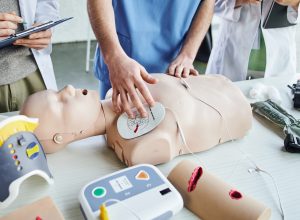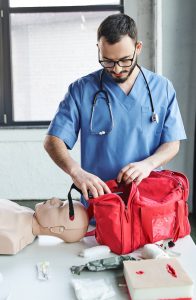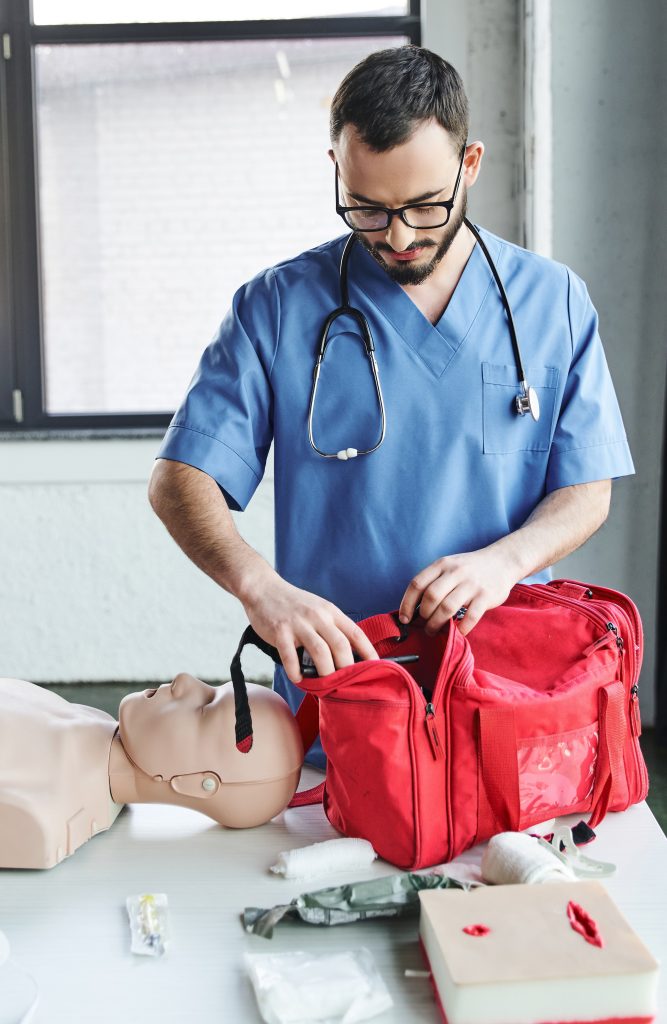Running a CPR class takes more than knowledge—it takes the right equipment. When supplies are missing or run out mid-session, learners notice, confidence drops, and valuable time is lost. The best instructors anticipate these challenges by packing reliable cpr supplies that make classes smooth, hygienic, and efficient.
This guide breaks down 10 essentials every CPR instructor should carry in 2025, with practical tips for avoiding shortages, saving money, and keeping training portable.
Note: CPR training prepares people for emergencies but does not replace professional medical care. For a clear overview of CPR and why it matters, visit the American Heart Association’s resource on What Is CPR.
The must-have supply list at a glance
Here are the 10 categories you’ll want in your bag at all times:
- Disposable lungs and valves
- Face shields and barrier devices

- Nitrile gloves
- Cleaning wipes and sprays
- AED trainer, pads, and batteries
- Pocket masks
- Replacement faces and airway parts
- Carry cases and organizers
- Consumable bundles sized to your classes
- Backup tools for small fixes
👉 Ready to order? Visit the CPR Depot USA shop for fast shipping and reliable inventory.
1) Disposable lungs and valves
Every learner needs their own set of lungs or airway bags. Reusing these consumables compromises hygiene and can affect airflow during practice.
Instructor challenges: These run out faster than anything else. Forgetting spares means splitting practice or skipping breaths altogether.
Best practices:
- Carry 1.5–2x your class size in extras.
- Separate adult, child, and infant sizes with color-coded bags.
- Keep an unopened pack as your “emergency reserve.”
2) Face shields and barrier devices
Flat face shields or molded barrier devices give learners confidence during rescue breath practice. They’re affordable, disposable, and easy to replace.
Why it matters: Many students hesitate to deliver breaths. A shield or valve barrier makes practice safer and more comfortable.
Teaching tip: Show how to unroll and position the shield before students try it. This prevents awkward delays mid-class.
3) Nitrile gloves in multiple sizes
Gloves set the tone for professionalism and safety. Handing them out at the start of class builds good habits learners carry into real life.
Why nitrile? They’re latex-free, strong, and available in multiple sizes. Unlike vinyl gloves, they don’t tear easily during compressions.
Packing tip: Pre-pack gloves in pairs (small bags or envelopes) so distribution is quick. This keeps your setup organized and efficient.
4) Cleaning wipes and sprays
Quick cleaning between learners is non-negotiable. It protects students, protects your equipment, and signals to learners that hygiene is part of CPR readiness.
What to include:
- Alcohol-based wipes for face and chest areas.
- A mild spray cleaner for surfaces and carry cases.
- Soft microfiber cloths to prevent scratching.
Routine: After each student, wipe down the high-contact areas. Between classes, spray and let everything air-dry before packing away.
5) AED trainer, pads, and spare batteries
AED practice is as critical as chest compressions. A reliable AED trainer makes sure learners can apply pads correctly and follow prompts under pressure.
What to pack:
- Adult and child pads labeled clearly.
- At least one spare set of pads.
- Extra batteries (AA/AAA) to avoid dead trainers.
Pro tip: Demonstrate proper pad placement with removable tape on the manikin’s chest. This gives students a visual guide they won’t forget.
6) Pocket masks with one-way valves
Pocket masks are a step above flat shields, allowing learners to practice sealing their lips properly around a mask dome.
Features to look for:
- Transparent dome for visual chest rise.
- Replaceable valves for hygienic use.
- Hard cases that protect the mask in your kit.
Pocket masks are especially valuable for healthcare learners, who need realistic airway practice beyond shields.
7) Replacement faces and airway parts
Manikins wear down with repeated use. Having spare parts keeps classes running smoothly without canceling sessions or rushing a last-minute order.
Benefits:
- Prevents delays if a nose, valve, or skin tears mid-class.
- Keeps manikins looking clean and professional.
- Extends overall life of your equipment.
Organizing tip: Label parts by manikin model to avoid mixing components.
8) Carry cases and organizers
Supplies don’t help if you can’t find them. A portable case with compartments saves time during setup and teardown.
What to choose:
- Padded sections for torsos and AED trainers.

- Mesh pockets for small consumables.
- Clear or labeled pouches for gloves, wipes, and shields.
Time-saver: Keep a “quick access” pocket with the most-used items: gloves, wipes, and shields.
9) Class-size consumable bundles
Ordering one-by-one leads to shortages. Bundles sized for 10, 20, or 30 learners simplify planning and reduce costs.
Advantages:
- Predictable inventory for recurring classes.
- Lower cost per student.
- Reduced reordering headaches.
Smart habit: Keep one sealed bundle aside as your emergency backup.
10) Backup tools and repair essentials
It’s the little things that keep class moving.
Pack these extras:
- Batteries for trainers and feedback devices.
- Painter’s tape for pad placement practice.
- A small screwdriver, cotton swabs, and zip ties.
- Alcohol swabs for quick cleanups.
One small repair kit can save an entire class from disruption.
Pair with a CPR dummy for true realism
Supplies make a class run smoothly, but students need lifelike practice. A reliable cpr dummy with good chest recoil and feedback helps learners build muscle memory.
- Rotate learners through adult, child, and infant models.
- Choose lightweight torsos if you travel often.
- Look for quick-swap parts to save time between students.
👉 Shop manikins and supplies together at the CPR Depot USA shop.
Buying smart: how to choose quality, availability, and portability
Not all supplies are created equal. The best instructors weigh three factors:
- Quality: Choose parts made for your manikin model. Off-brand pieces may not fit properly.
- Availability: Track consumption after each class. Reorder before you hit your reserve stock.
- Portability: Favor lightweight torsos, compact AED trainers, and carry cases with compartments for organized travel.
Restock and care schedule for instructors
A predictable routine keeps gear ready and saves you money long-term.
- After each class: Wipe down manikins, swap single-use parts, and restock gloves.
- Monthly: Inspect recoil mechanisms, replace worn faces or valves, and test AED trainers.
- Quarterly: Adjust bundle sizes based on average usage. Retire old parts to a demo-only bin.
Consistency ensures every learner gets the same quality training experience.
Build your kit with expert help
Choosing supplies can feel overwhelming, but you don’t have to do it alone.
👉 Next step: Use our Contact Us page to share your class size, budget, and needs. We’ll recommend supplies that match your program—or head straight to the CPR Depot USA shop to order essentials today.
FAQs
What CPR supplies run out the fastest?
Disposable lungs, face shields, and wipes. Stock extras and keep a sealed emergency bundle.
How many manikins should I plan for?
Most instructors recommend a 2–3:1 student-to-manikin ratio.
Can I reuse consumables across classes?
Airway bags and valves should always be swapped after each student. Reusable parts like torsos or masks must be cleaned between sessions.
How often should I restock?
Do a quick check after every class, reorder monthly, and review your average usage quarterly.
Are pocket masks required for every class?
Not required, but highly recommended. They improve realism and seal practice compared to flat shields.

